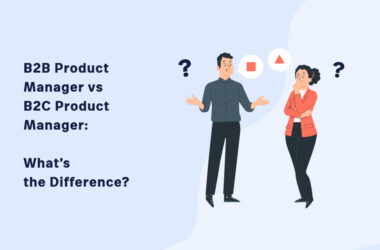Are you tired of building features that users don’t actually want? User stories can help you avoid that pitfall.
By focusing on the user’s needs and goals, user stories ensure that each sprint delivers features customers truly value.
In this article, we’ll walk you through a step-by-step process for writing effective user stories that drive customer satisfaction and improve product outcomes.
TL;DR
- A user story describes a software feature or functionality from the user’s perspective. Agile user stories focus on explaining the “who,” “what,” and “why” of a software requirement, making it easily understandable for both technical and non-technical product team members.
- The benefits of writing user stories include improved team collaboration, avoiding expensive product development mistakes, and promoting a user-centric culture.
- No matter how well written, a standard user story isn’t without its disadvantages. User stories are usually time-intensive, too narrow, and may exclude important details.
- In most companies, it’s the product owner or product manager who is responsible for writing user stories. However, any member of the Agile team can write user stories.
- User stories are written at the start of the agile software development process. Then, refined, adjusted, and expanded as the team gains more insights.
- Here is an example of a good user story: “As a sales representative, I want to receive automated reminders for follow-up calls and emails so that I can stay engaged with potential leads and improve sales conversion rates.”
Follow these 5 steps to create good user stories:
- Outline the definition of “done.”
- Identify your customer personas and use that information to create your user story template.
- Create tasks and subtasks for your user story.
- Map user stories in the form of ordered steps that include your major and smaller user stories.
- Collect user feedback and iterate to ensure you strike a balance between delivering business value and meeting user needs.
Userpilot helps product teams like yours understand users better and write user stories that drive satisfaction. Book a demo now to begin.
What are user stories?
A user story is an informal description of a feature or functionality told from the user’s perspective.
It serves as a way to capture the “who,” “what,” and “why” of a software requirement in plain language, making it easily understandable for both technical and non-technical product team members.

Benefits of user stories
User stories are a core component of the agile methodology. They aim to ensure that the product development process remains user-focused and efficient.
Here are some of the key benefits:
- Promote a user-centric approach: A user story inherently focuses on the needs and experiences of the end user. By defining features from the user’s perspective, development teams can prioritize functionality that delivers the most user value. This ensures that the final product aligns with user expectations and improves overall satisfaction.
- Improve collaboration: A well-crafted user story creates a common language and understanding between stakeholders (product managers, developers, designers, etc.), allowing everyone to contribute.
- Prevent development mistakes: Because agile user stories clearly define the “why” behind a feature, they provide valuable context for the development team. This helps developers make informed decisions and avoid building the wrong thing or implementing a feature in a way that doesn’t actually solve the user’s problem.
Disadvantages of user stories
While a user story offers many benefits, it’s important to be aware of some potential challenges it can present:
- May exclude necessary details: By design, user stories are meant to be brief and focused on user needs. However, this brevity can sometimes lead to a lack of essential technical or implementation details.
- Time-intensive: User stories often involve continuous engagement from product owners, stakeholders, and development teams to ensure each story accurately reflects user needs and project goals. This iterative process can consume significant resources, especially in complex products with numerous user stories.
- Too narrow: User stories typically focus on individual features or functionalities from a single user’s viewpoint. This can make it difficult to see the bigger picture and understand how different features contribute to the overall user experience.
Who is responsible for writing user stories?
It depends on the company. In most cases, the product owner is primarily responsible for creating user stories and setting priorities.
However, any other product team member (such as the UI/UX designer or product manager) can write a user story since it doesn’t require much technical knowledge.
For greater effectiveness, it’s best to make it a collaborative process with input from different members of the product and development team.
When are user stories written?
Product teams typically write user stories throughout the agile project, beginning during the initial stages of product planning and continuing through each sprint.
At the start of the agile project, key stakeholders collaborate to create an initial backlog of user stories. These stories outline the core features and functionalities the team needs to add over the course of the project or a three-to-six-month release cycle.
Throughout the development cycle, new user stories may emerge as the team gains a deeper understanding of the project requirements and receives user feedback.
How to write a user story in 5 steps
Now that you’ve understood user stories, it’s time to learn how to write them. Follow these steps:
Outline the definition of “done”
This step involves establishing a crystal-clear understanding of what it means for a user story to be successfully completed.
Think of it as crafting a detailed checklist that leaves no room for ambiguity. Your definition of done (or acceptance criteria) should be specific and measurable.
Write it in a way so that anyone on the team, whether they are a developer, designer, or stakeholder, can look at it and instantly know if the feature has been fully implemented.
For example, instead of simply stating, “As a user, I can log in,” the acceptance criteria might include details like:
- Successful login: The user is redirected to the account dashboard upon entering the correct credentials.
- Error handling: Clear error messages are displayed for incorrect credentials or system issues.
- Security: Password requirements are enforced, and login attempts are limited to prevent brute-force attacks.
By defining these detailed criteria upfront, you can avoid misunderstandings and ensure that the finished product perfectly aligns with user needs.
Identify your user personas
Employ various user research methods such as interviews, surveys, focus groups, and observational studies to gather valuable insights into your target audience.
Next, consolidate your findings into user personas—fictional representations of your ideal users that encapsulate user goals, pain points, and motivations.
By mapping these important details onto a persona template, you create a tangible reference point for crafting a user story that resonates with your target audience.

Create tasks and subtasks
Once you have a clear understanding of your personas and their needs, it’s time to break down the user stories into smaller, more manageable tasks and subtasks.
For instance, a user story like “As a user, I can create a shopping list” might involve tasks like:
- Design the user interface for the shopping list page.
- Develop the functionality to add items to the list.
- Implement a feature to categorize items.
- Enable users to save and share their lists.
You can break each of these into subtasks, such as creating wireframes, writing code, conducting user testing, and so on.
This meticulous breakdown ensures that no detail is overlooked and that the development team has a clear roadmap to follow.

Map user stories in the form of ordered steps
Visualize the user journey through the product or feature you’re building and create detailed user stories covering each key step.
By creating a visual map, it becomes easier to identify dependencies between stories, prioritize features based on their impact on the overall user experience, and foster better collaboration among your team members.

Collect user feedback and iterate
After implementing a user story, it’s time to gather insights from real users.
This could involve conducting user testing sessions, sending out surveys, or having one-on-one interviews with a few users.
Choose a feedback format that best suits you. Then, ask questions to help you understand how users interact with the new features and gather valuable suggestions for future iterations.
For most agile companies, in-app surveys are the most convenient method as they are fast to create and easy to analyze.

After collecting the data, analyze user responses and use the insights to refine your stories, add details, or remove unnecessary elements.
For example, if users consistently mention struggling to find a specific feature, you might add a more prominent button or refine the navigation to make it easier to locate.
User story examples
Need some examples to get your inspiration rolling? Here are a few:
- As a sales representative, I want to receive automated reminders for follow-up calls and emails so that I can stay engaged with my leads and improve sales conversion rates.
- As a project manager, I want to create task dependencies and assign resources so that I can ensure the timely completion of complex projects.
- Being a marketing manager, I want to see a dashboard of key metrics (website traffic, lead conversion rate, customer acquisition cost) so that I can quickly assess the effectiveness of our marketing campaigns.
Key takeaways:
- Focus on the user’s role: Notice how each user story clearly identifies the specific type of user (e.g., sales representative, project manager, marketing manager).
- Highlight the “why”: The user stories above not only state the user’s desired action (e.g., see a dashboard) but also explain the reason behind it (e.g., assess campaign effectiveness).
- Keep it concise: Notice how each user story is expressed in a single sentence. This brevity ensures that the core user need is clear and easily understandable. Avoid overly complex or lengthy descriptions.
- Use action-oriented language: Each user story clearly states what the end user wants to do (e.g., “see a dashboard,” “create task dependencies,” “receive reminders”). This action-oriented language makes the stories more concrete and actionable for the product development team.
Conclusion
User stories are easy to write. Anyone can do it. However, what differentiates a good story from a bad one is the amount of user research that goes into it.
Without a proper understanding of the needs, motivations, and pain points of your target audience, it’s almost impossible to create stories that resonate with them.
Pairing in-app analytics with customer feedback tools, Userpilot helps product teams like yours understand users better and craft stories that align with core user needs. Book a demo now to discuss your needs and get tailored solutions.






